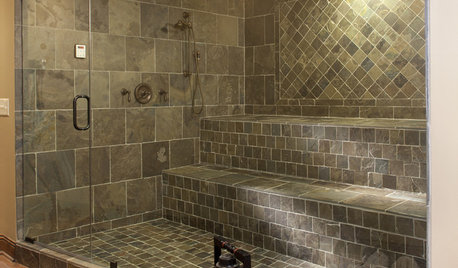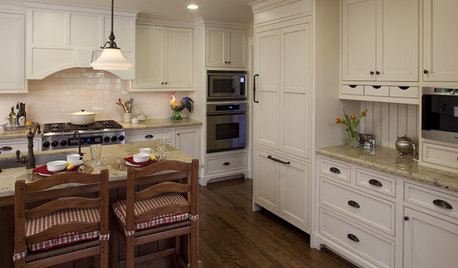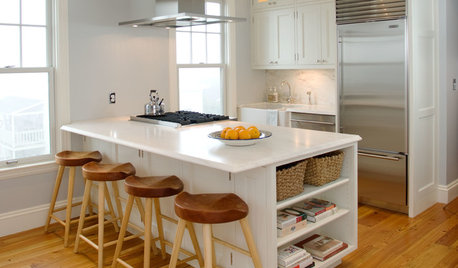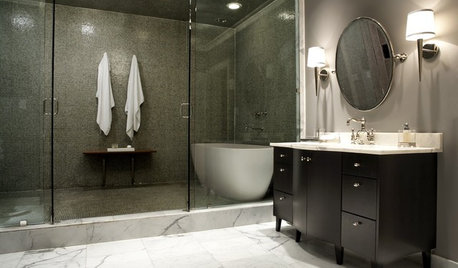Mold from the Dishwasher Steam
esanjays96
16 years ago
Featured Answer
Comments (53)
teedup1
16 years agoRelated Discussions
Dishwasher steam damaging counter
Comments (5)I used some of that Redguard rubbery paint on vapor membrane that you use underneath shower flooring and walls. It's pretty thick and substantial. We have butcher block counters, and the steam from the DW hasn't caused a problem yet. We had a bucket of it left over from a project: http://www.custombuildingproducts.com/ProductCatalog/SurfacePrep/WaterproofingAntiFractureMembranes/RedGard.aspx?user=diy&lang=en...See MoreDishwasher steam damaging counter
Comments (13)Vapor barriers should be installed with most modern DWs if a laminate counter (or butcher block) is used. (Look at the Ikea site countertops specs to get an idea of what I'm talking about). Either seal the underside of the laminate with a good primer like KIlZ for at least a foot on either side, and then topcoat that with whatever you've got leftover that isn't flat paint. Preferably semi gloss made for kitchens and baths, as that usually has a mold inhibitor in it, but plain semi gloss is fine. Or, you can staple 6 mil plastic to the underside of the laminate, covering the staples with caulk, and drape it down over the sides of the DW. You also should encourage as much air flow in your kitchen as possible to dry the moisture that escapes and condenses into water against the vapor barrier. That doesn't mean leaving a gap that sound can escape, but it does mean maybe turning on a ceiling fan, or using the AC in the summer to dry things out as well as using an externally venting fan to let the moisture from cooking escape so the interior air is actually dry enough to evaporate the DW moisture....See MoreDishwashers and problems with steam warping the panel
Comments (3)It is an unfortunate fact of life that water damages wood. It sounds like a poor panel ready design from Jennair that would vent a DW right onto a wood panel. The wood is doing what is normal with wood in the presence of moisture: it's warping. Swapping out the DW or putting on a stainless front would seem to be the only real solution here as it's not the cabinet company's fault that Jennair created a sauna for their cabinetry. As far as the toekick, you said "in that area". Is it only warping next to the DW? Or are there other areas that are affected? If just the DW, the steam from the vent is probably the culprit again, but I would pull the DW to be sure there are no leaks that you haven't spotted. Also, while tile floors are designed to be "damp mopped", the toekick isn't designed to stand up to soaking. Your mop should be wrung out so that it doesn't drip. That way any moisture that is applied to your floor--and gets on your toekick-- dries quickly....See MoreWhy does our Miele dishwasher leak steam?
Comments (4)If Its not supposed to happen, and if at some point damage to the surrounding materials is going to happen and the Miele techs are at a loss and its new…Its time to insist on a replacement. You probably have a lemon, it happens. The problem is getting Miele to agree, good luck with that. With my kitchenaid, the tech just had to call the company and say it was beyond repair and I got a new dishwasher....See Moreantss
16 years agocpovey
16 years agoionized_gw
16 years agoasolo
16 years agoesanjays96
16 years agoesanjays96
16 years agoantss
16 years agoglinda
16 years agoglinda
16 years agoheimert
16 years agoteedup1
16 years agoteedup1
16 years agoweedmeister
16 years agolascatx
16 years agolascatx
16 years agomccall
16 years agoteedup1
16 years agoesanjays96
16 years agoteedup1
16 years agocheryl217
16 years agojamesk
16 years agoesanjays96
16 years agojamesk
16 years agoweissman
16 years agoantss
16 years agosharon_s
16 years agoesanjays96
16 years agoteedup1
16 years agochipshot
16 years agoteedup1
16 years agoesanjays96
16 years agochipshot
16 years agojamesk
16 years agoantss
16 years agodadoes
16 years agoesanjays96
16 years agoantss
16 years agodadoes
16 years agoci_lantro
16 years agoblackflyshirt
13 years agobeckerrubinfamily
8 years agoJo
8 years agolast modified: 8 years agoweedmeister
8 years agoeshmh
8 years agolast modified: 8 years agoAngela C
7 years agoDerrick L
7 years agoLori HL
4 years agolast modified: 4 years agoHU-173992044
3 years ago
Related Stories

HOUSEKEEPINGTackle Big Messes Better With a Sparkling-Clean Dishwasher
You might think it’s self-cleaning, but your dishwasher needs regular upkeep to keep it working hard for you
Full Story
HOUSEKEEPINGDishwasher vs. Hand-Washing Debate Finally Solved — Sort Of
Readers in 8 countries weigh in on whether an appliance saves time, water and sanity or if washing by hand is the only saving grace
Full Story
SHOWERSSteam Showers Bring a Beloved Spa Feature Home
Get the benefits of a time-honored ritual without firing up the coals, thanks to easier-than-ever home steam systems
Full Story
KITCHEN DESIGN9 Molding Types to Raise the Bar on Your Kitchen Cabinetry
Customize your kitchen cabinets the affordable way with crown, edge or other kinds of molding
Full Story
KITCHEN DESIGN20 Kitchen Must-Haves From Houzz Readers
We asked you to tell us your top kitchen amenities. See what popular kitchen features made the list
Full Story
TILETop Tile Trends From the Coverings 2013 Show — the Wood Look
Get the beauty of wood while waving off potential splinters, rotting and long searches, thanks to eye-fooling ceramic and porcelain tiles
Full Story
REMODELING GUIDESGet What You Need From the House You Have
6 ways to rethink your house and get that extra living space you need now
Full Story
HOMES AROUND THE WORLDHousehold Habits and Customs to Borrow From Other Countries
Discover why salt may be the perfect house-warming gift, how to clean rugs in snow and why you should invest in a pair of ‘toilet slippers’
Full Story
KITCHEN DESIGNKitchen of the Week: Pushing Boundaries in a San Francisco Victorian
If the roll-up garage door doesn’t clue you in, the blue cabinets and oversize molding will: This kitchen is no ordinary Victorian galley
Full Story
BATHROOM DESIGNHow to Choose Tile for a Steam Shower
In steamy quarters, tile needs to stand up to all that water and vapor in style. Here's how to get it right the first time
Full Story



glennsfc